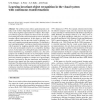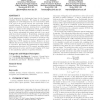68 search results - page 4 / 14 » Recognition by Variance: Learning Rules for Spatiotemporal P... |
IJCAI
1989
13 years 8 months ago
1989
Classification methods from statistical pattern recognition, neural nets, and machine learning were applied to four real-world data sets. Each of these data sets has been previous...
ICVGIP
2004
13 years 9 months ago
2004
In this paper we present a simple framework for activity recognition based on a model of multi-layered finite state machines, built on top of a low level image processing module f...
BC
2006
13 years 7 months ago
2006
Abstract The cerebral cortex utilizes spatiotemporal continuity in the world to help build invariant representations. In vision, these might be representations of objects. The temp...
GIS
2007
ACM
14 years 1 months ago
2007
ACM
As technology advances we encounter more available data on moving objects, thus increasing our ability to mine spatiotemporal data. We can use this data for learning moving object...
GECCO
2007
Springer
14 years 1 months ago
2007
Springer
Credit assignment is a fundamental issue for the Learning Classifier Systems literature. We engage in a detailed investigation of credit assignment in one recent system called UC...


